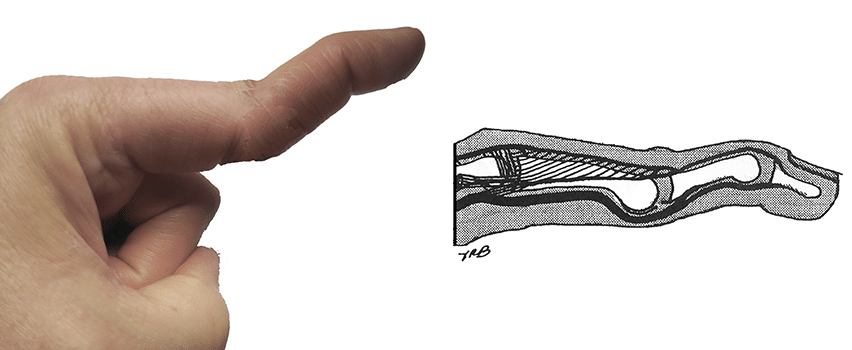Description
In a swan neck deformity, the middle joint of a finger is extended (bent back) more than normal. The end joint is flexed (bent down) (Figure From The Right).

Figure: (Left) A swan neck deformity (Right) The anatomy of a swan neck deformity
CauseshEL
The usual cause of a swan neck deformity is weakness or tearing of a ligament on the palm side of the middle joint of the finger. Sometimes it is caused by tearing of the tendon that flexes the middle joint. In other cases, injury of the tendon that straightens the end joint is the cause. This weakness or tearing of the ligament and tendon can be from an injury or from rheumatoid arthritis.
As the finger middle joint extends, there is sliding of other tendons toward the back of the finger (Figure 2). This causes more extension of the middle joint. As a result, the ability of the tendons to straighten the end joint becomes lessened and eventually causes the bending.
Signs and SymptomsH
This deformity can cause difficulty bending the middle joint because of the location of the tendons. A snapping sensation can happen during bending. Long-lasting deformities can become stiff.
Treatment
There are many treatments available for a swan neck deformity. The treatment type may vary depending on the main cause of the deformity and whether or not the deformity is stiff.
Nonsurgical Options
One non-invasive option involves a special type of ring for the middle joint that can be used to help correct the position and stop the snapping.
Surgical Options
Surgical treatments are many and varied. They mainly involve prevention of the abnormal middle joint extension. Some involve repositioning of the tendons on the side of the middle joint. If the middle joint is stiff or arthritic, the joint may be replaced or fused in a slightly bent position.
Your hand surgeon can work with you to discuss the best possible treatment, whether or not it involves surgery.
